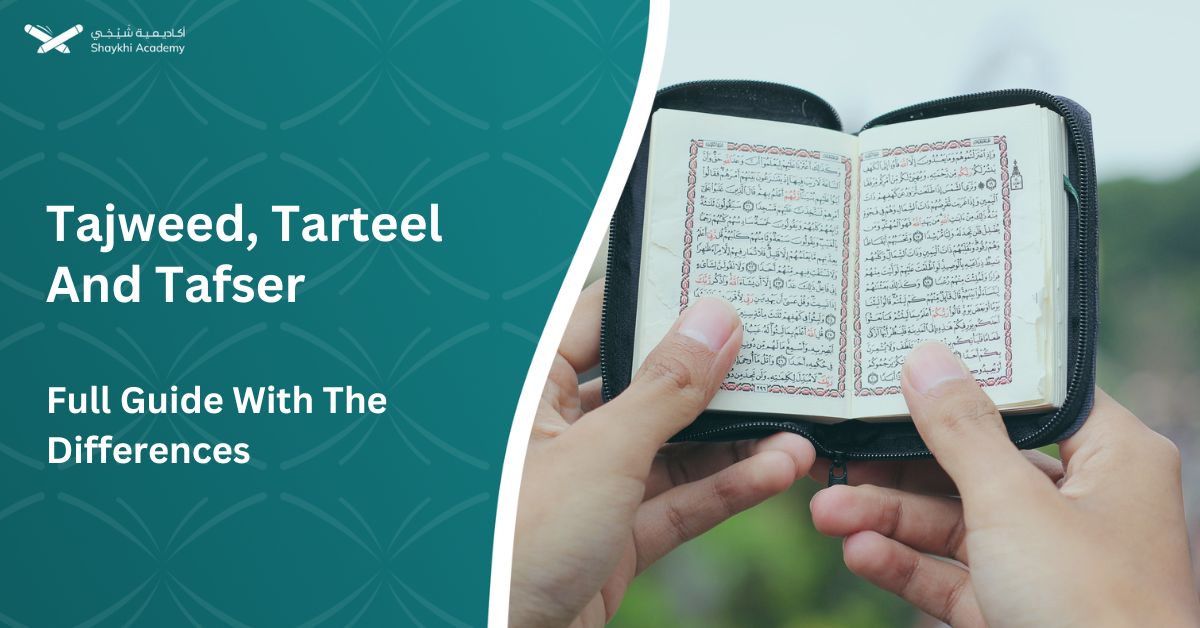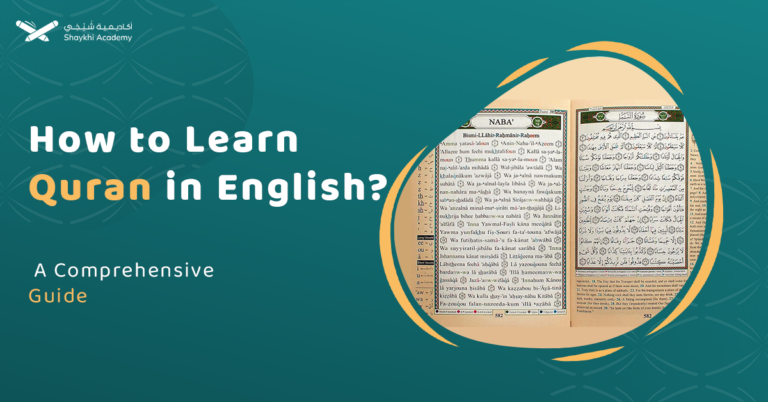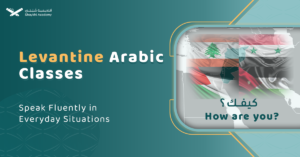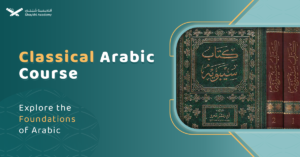During your journey of learning the Quran, you will encounter some expressions that refer to specific concepts.
It’s important to understand these terms to differentiate between them. In this article, we will explain the main differences between three key terms: Tajweed, Tafseer, and Tarteel.
Let’s begin.
Differences between Tajweed, Tafseer, and Tarteel
The mean difference between Tajweed and Tafseer is that while Tajweed focuses on the precise pronunciation of Quranic letters and recitation rules, Tafseer involves the explanation and interpretation of Quranic verses. Similarly, the mean difference between Tajweed and Tarteel is that Tajweed ensures correct articulation of letters, whereas Tarteel emphasizes slow, rhythmic recitation with a focus on these Tajweed rules.
Here is a table of th differences and similarity:
| Aspect | Tajweed | Tafseer | Tarteel |
| Meaning | Art and science of proper Quranic pronunciation | Explanation and interpretation of Quranic verses | Slow, rhythmic recitation of the Quran |
| Primary Focus | Correct articulation of letters and recitation rules | Clarifying the meanings and messages of the Quran | Proper recitation with attention to Tajweed |
| Types / Levels | – Mem Moshaddadh and Noon Moshaddadah | – Tafseer bil Mathur | – Al Tahqiq (slow and deliberate) |
| – Noon Sakinah and Tanween | – Tafseer bil Ra’i | – Al Hadr (fast with proper rules) | |
| – Other specific rules | – Forbidden Tafseer | – Al Tadweer (intermediate speed) | |
| N/A | N/A | – Al Tarteel (standard recitation) | |
| Objective | Ensuring correct pronunciation and recitation | Providing understanding and context | Reflecting on the meanings through careful recitation |
| Additional Notes | Essential for correct Quranic recitation | Requires deep knowledge and expertise | Often used in prayer and recitation |
Lets Discuss each one of them in details:
The meaning of Tajweed
The word “Tajweed” means to beautify or perfect something. In the context of learning the Quran, Tajweed refers to the art and science of correctly pronouncing the letters of the Quranic text, ensuring that it is recited as Prophet Muhammad (peace be upon him) recited it.
It encompasses the rules that govern the proper recitation of the Quran, including the pronunciation of letters and the guidelines for starting and stopping recitation.
Types of Tajweed
It is important to learn the various rules of Tajweed, as understanding these rules facilitates proper recitation of the Quran. By comprehending and applying these rules, the recitation becomes more accurate and closer to the way it was revealed.
Let’s explore Two key types of Tajweed rules.
1- Meem Mushaddadah (م) and Noon Mushaddadah (ن)
Meem Mushaddadah (م) and Noon Mushaddadah (ن) rule pertains to the letters Meem (م) and Noon (ن) when they carry a Shaddah (ّ), which is a diacritical mark indicating that the letter should be doubled and pronounced with emphasis.
The presence of a Shaddah on these letters means that they must be recited with a specific pronunciation rule called Ghunna (nasalization), the duration of Ghunna is 2 counts.
2- Noon Sakinah and Tanween
Noon Sakinah and Tanween rule applies when encountering Noon Sakinah or Tanween in the Quranic text.
Noon Sakinah refers to the letter Noon (ن) with a sukoon ( ْ ), meaning it has no vowel sound. Tanween refers to a form of pronunciation that indicates the presence of a Noon sound at the end of a word, represented by double diacritical marks: two fathas (ــًـ), two dammas (ــٌـ), or two kasras (ــٍـ).
Depending on the following letter, one of the following rules is applied:
- Izhar (Clear Pronunciation)
Izhar happens when Noon Sakinah or Tanween is followed by one of these letters: (ء، ه، ع، ح، غ، خ) The Noon sound is pronounced clearly without Ghunna (nasalization).
Example: In the phrase(عليمٌ حكيم), the Tanween on the letter م is pronounced as Noon, and the letter ح is pronounced clearly without nasalization.
- Idgham (Assimilation)
Idgham happens when Noon Sakinah or Tanween is followed by one of these letters: (ي، م، و، ن، ل، ر)The Noon sound merges with the following letter.
The rule of Ghunna (nasalization) is applied except when followed by ل or ر, where it is pronounced without Ghunna.
Example with Ghunna: In the phrase (مَنْ يَعْمَلْ), the Noon Sakinah (ن) is followed by ي, so the Noon sound is assimilated, and Ghunna is applied.
Example without Ghunna: In the phrase(مِنْ لَدُنْهُ), the Noon Sakinah (ن) is followed by ل, so the Noon sound is assimilated without Ghunna.
There are additional rules related to Noon Sakinah and Tanween, as well as other types of Tajweed rules. You can learn these in detail with qualified teachers at Shaykhi Academy.
Read more about all the rules of Tajweed in detail.
The meaning of Tarteel
The word “Tarteel” means to measure or slow down. In the context of learning the Quran for beginners, it refers to the slow, measured, and rhythmic recitation of the verses.
Tarteel is considered a level of Tajweed, which includes proper articulation of letters and knowing where to pause or stop during recitation.
It emphasizes clear and deliberate recitation, allowing for thoughtful reflection on the meanings of the verses.
Types of Tarteel
There are various levels or categories of reciting the Quran, including Tarteel. These levels are divided as follows:
1. Al Tahqiq
This level involves reciting the Quran slowly, with careful attention to understanding the meaning of the verses and focusing on Tajweed rules. It emphasizes the correct pronunciation of each letter. Al Tahqiq is especially suitable for learning.
2. Al Hadr
This level involves reciting the Quran quickly while still adhering to Tajweed rules and ensuring the correct pronunciation of each letter. It is characterized by a faster pace of recitation.
3. Al Tadweer
This level involves reciting the Quran at an intermediate speed, balancing between the slow pace of Al Tahqiq and the faster pace of Al Hadr. It maintains a moderate rhythm.
4. Al Tarteel
Some scholars mention that Al Tarteel is similar to Al Tahqiq, with both emphasizing careful recitation. However, Al Tahqiq is primarily for learning purposes, while Al Tarteel is the style of recitation that a Quran reader adopts after mastering the rules during the learning stage.
The meaning of Tafseer
The word “Tafseer” means “to explain.” In the context of the Quran, Tafseer refers to the explanation or interpretation of the meanings of the Quranic verses. It involves providing context, understanding the reasons for revelation, and clarifying the message and teachings contained in the Quran.
Types of Tafseer
There are two types of tafseer; Al Tafseer bil Mathur and Al Tafseer bil Ra’i. Al Tafseer bil Mathur relies on authentic sources like the Quran, Sunnah, and Sahaba’s explanations, while Al Tafseer bil Ra’i is based on personal reasoning and linguistic knowledge, with a warning against interpretations lacking proper understanding.
1. Al Tafseer bil Mathur
This type of Tafseer involves interpretation based on the Quran, the Sunnah, or the explanations provided by the Sahaba (companions of Prophet Muhammad, peace be upon him).
It relies on authentic sources to clarify the meanings of the Quranic verses as intended by Allah Subhanahu wa ta’ala.
Examples of Al Tafseer bil Mathur books include Tafseer Ibn Kathir, Tafseer Ibn Attiya, Tafseer Al-Tabari.
2. Al Tafseer bil Ra’i
The word “Ra’i” means “opinion.” This type of Tafseer involves interpreting the Quran using personal reasoning and understanding, based on the scholar’s knowledge of the Arabic language, the meanings and nuances of Arabic words, the context of the verses, and other necessary tools for explaining the Quran.
It requires a deep understanding of linguistic, historical and aqa’ida aspects to provide interpretations that align with Islamic principles and teachings.
It’s important to note that there is a forbidden type of Tafseer, where a person attempts to interpret the Quran without proper knowledge of the Arabic language or explains its meaning based solely on their personal opinion, rather than following the established rules and guidelines we previously mentioned.
How to learn Tajweed, Tarteel and Tafser
Continuity and patience are fundamental keys to enhancing your recitation while learning and practicing Tajweed, Tarteel, and Tafseer. By maintaining a consistent study routine and exercising patience, you can progressively improve your skills. Here are some tips to help you in this journey.
1- Learning the basics of Tajweed
To effectively learn Tajweed, Tarteel, and Tafseer, start by mastering the basics of Tajweed. Understanding and practicing fundamental Tajweed rules will make them more familiar and easier to apply over time, thereby improving your Tarteel as well.
Learn Tajweed and recitation with Shaykhi.
2- Practice what you learn
Practicing what you learn is crucial. Once you’ve grasped the basics of Tajweed rules and read Tafseer books to understand the meanings of the verses, apply this knowledge consistently. This will enhance both your recitation accuracy and comprehension of the Quranic text, leading to an improved Tarteel.
3- Ask for a Qualified Teacher
While the previous advice might seem challenging, having a qualified teacher can make a significant difference.
A knowledgeable teacher can assist you in learning the basic rules of Tajweed, help you with correct pronunciation, and guide you in understanding the meanings of the verses. This support will make your learning journey easier and improve your recitation over time. At Shaykhi Academy, we have a number of qualified teachers ready to assist you in your Tajweed, Tarteel, and Tafseer studies.
Unlock the Path to Quranic Mastery with Shaykhi Academy!
Are you seeking the finest Quranic education right from the comfort of your home? Look no further! Shaykhi Academy stands out as a premier online Quran learning platform, dedicated to providing exemplary education to both children and adults.
Why Choose Shaykhi Academy?
- Connect with highly qualified native tutors.
- Flexible scheduling to suit your busy lifestyle.
- Affordable classes tailored for all levels.
- Accessible from anywhere around the globe.
Discover Our Range of Courses:
- Arabic Noorani Qaida: Lay a solid foundation for Quranic studies.
- Online Quran Classes for Kids: Engaging lessons for lifelong learning.
- Tajweed Rules for Kids: Learn to recite with confidence.
- Quran Hifz for Kids: Step-by-step guidance to memorize the Quran.
- Quran for Adults: Introduce yourself to Quran reading and Tajweed rules.
- Online Arabic Courses: Master the language of the Quran.
- Islamic Studies: A wide range of topics related to Islam, including theology, law, Quranic studies, and Hadith.
Don’t Miss Out on Your Chance to Excel!
Whether you’re a beginner or seeking advanced knowledge, Shaykhi Academy can guide you! Book your free trial now!
Conclusion
In the context of learning the Quran, Tajweed refers to the art and science of correctly pronouncing the letters of the Quranic text, ensuring that it is recited as Prophet Muhammad (peace be upon him) recited it.
We covered various Tajweed rules, including the pronunciation of Meem Mushaddadah (م) and Noon Mushaddadah (ن), as well as Noon Sakinah and Tanween with rules such as Ith-har (Clear Pronunciation) and Idgham (Assimilation).
We also discussed Tarteel, which involves the slow, measured, and rhythmic recitation of verses. Additionally, we explored types of Tafseer, including Al Tafseer bil Mathur and Al Tafseer bil Ra’i.
Understanding these concepts will enhance your recitation and interpretation of the Quran.













































